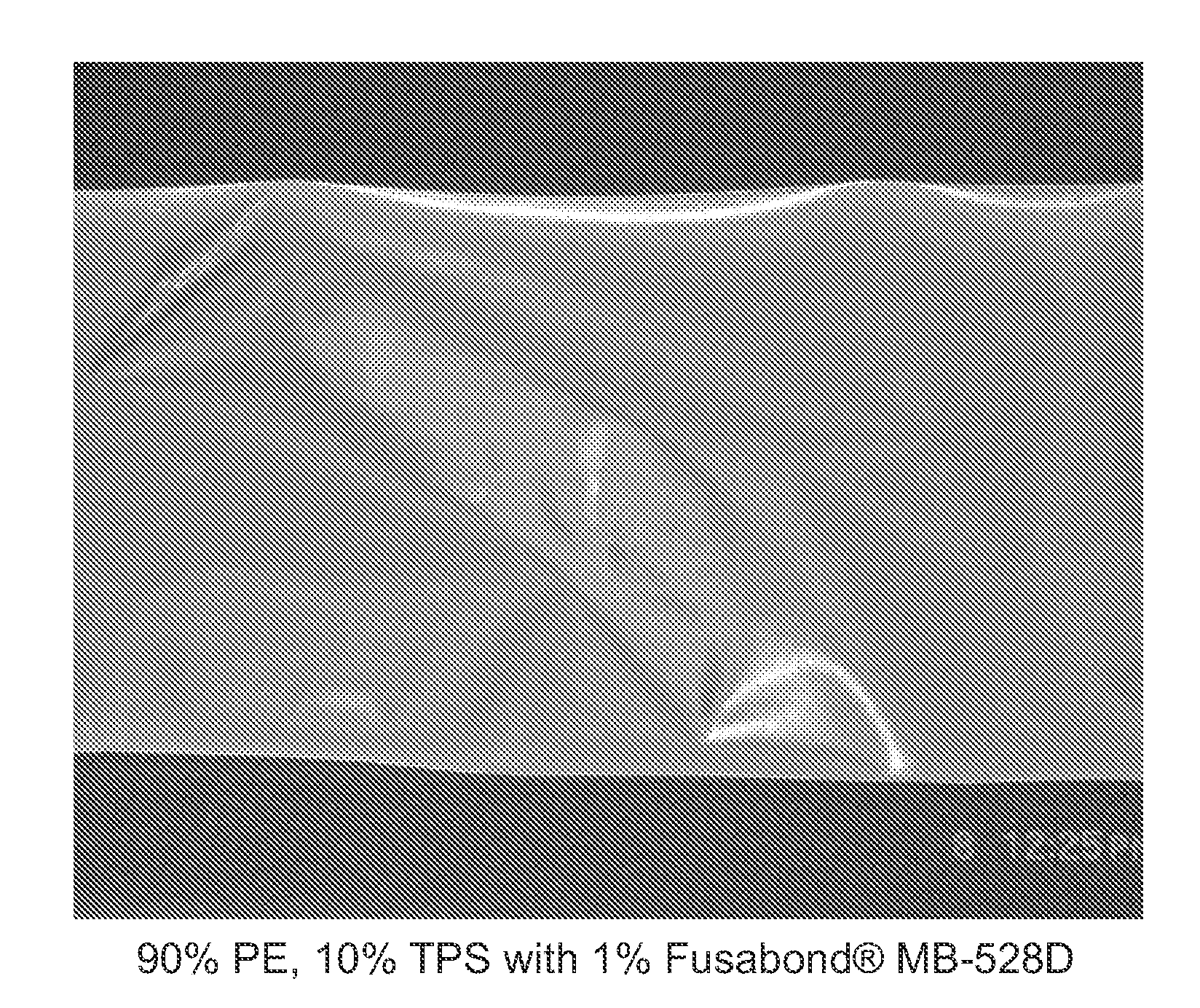Flexible thermoplastic films and articles
a polyolefin-based film, flexible technology, applied in textiles and papermaking, synthetic resin layered products, record information storage, etc., can solve the problems of brittle films, high stiffness and very low ductility, and relatively high rusting noise levels when handled, so as to increase the reaction level, weaken the film, and increase the strength of the film
- Summary
- Abstract
- Description
- Claims
- Application Information
AI Technical Summary
Benefits of technology
Problems solved by technology
Method used
Image
Examples
example 1
[0087]A mixture of 17% of a thermoplastic starch masterbatch (BL-F, produced by Biograde, Nanjing, China), 38% of a linear low density polyethylene (LLDPE) (melt flow rate of 1 and density of 0.918 g / cc, Grade 118 W, supplied by SABIC) and 38% low density polyethylene (LDPE) (melt flow rate of 2.8 g / 10 min and density: 0.925, Grade: Q281, supplied by SINOPEC Shanghai, Shanghai, China), and 7% white master batch (Shanghai Ngai Hing Plastic Materials Co., Ltd.) was fed to a single screw extruder blown film machine, the screw diameter was 150 mm, the Length / Diameter was 30 / 1. The die gap was 1.8 mm.
[0088]The other process conditions are listed in the following table:
NO. 8NO. 7NO. 6NO. 5NO. 4NO. 3NO. 2HEATERHEATERHEATERHEATERHEATERHEATERHEATERDie TemperatureTemperature(° C.)(° C.)(° C.)(° C.)(° C.)(° C.)(° C.)(° C.)Example 1180180180173164160.1146.5184Example 2180180180173164160.1146.5180Example 3180180180173164160.1146.5180
example 2
[0089]A mixture of 37% of a thermoplastic starch masterbatch (BL-F, produced by Biograde, Nanjing, China), 28% of a linear low density polyethylene (LLDPE) (melt flow rate of 1 and density of 0.918 g / cc, Grade 118 W, supplied by SABIC) and 28% low density polyethylene (LDPE) (melt flow rate of 2.8 g / 10 min and density: 0.925, Grade Q281, supplied by SINOPEC Shanghai, Shanghai, China), and 7% white master batch (Shanghai Ngai Hing Plastic Materials Co., Ltd.) was fed to a single single screw extruder blown film machine, the screw diameter was 150 mm, the Length / Diameter was 30 / 1. The gap was 1.8 mm.
example 3
[0090]A mixture of 57% of a thermoplastic starch masterbatch (BL-F, produced by Biograde, Nanjing, China), 18% of a linear low density polyethylene (LLDPE) (melt flow rate of 1 and density of 0.918 g / cc, Grade 118 W, supplied by SABIC) and 18% low density polyethylene (LDPE) (melt flow rate of 2.8 g / 10 min and density: 0.925, Grade: Q281, supplied by SINOPEC Shanghai, Shanghai, China), and 7% white master batch (Shanghai Ngai Hing Plastic Materials Co., Ltd.) was fed to a single screw extruder blown film machine, the screw diameter was 150 mm, the Length / Diameter was 30 / 1. The die gap was 1.8 mm.
Blowing Machine Condition:
[0091]The process conditions of the blown film extruder are summarized as follows:
NO. 8NO. 7NO. 6NO. 5NO. 4NO. 3NO. 2DieHEATERHEATERHEATERHEATERHEATERHEATERHEATERTemperatureTemperature(° C.)(° C.)(° C.)(° C.)(° C.)(° C.)(° C.)(° C.)Example 1180180180173164160147184Example 2180180180173164160147180Example 3180180180173164160147180
[0092]All the films from Examples 1, ...
PUM
| Property | Measurement | Unit |
|---|---|---|
| thickness | aaaaa | aaaaa |
| thickness | aaaaa | aaaaa |
| elongation | aaaaa | aaaaa |
Abstract
Description
Claims
Application Information
 Login to View More
Login to View More - R&D
- Intellectual Property
- Life Sciences
- Materials
- Tech Scout
- Unparalleled Data Quality
- Higher Quality Content
- 60% Fewer Hallucinations
Browse by: Latest US Patents, China's latest patents, Technical Efficacy Thesaurus, Application Domain, Technology Topic, Popular Technical Reports.
© 2025 PatSnap. All rights reserved.Legal|Privacy policy|Modern Slavery Act Transparency Statement|Sitemap|About US| Contact US: help@patsnap.com



